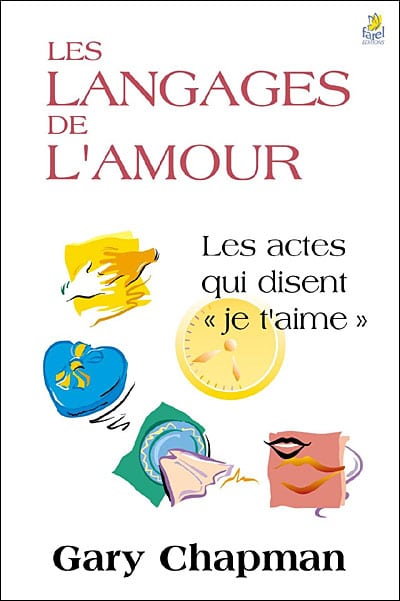
Depuis l’année dernière, j’ai eu l’occasion de parler à de nombreuses reprises de l’Ennéagramme : un modèle de la personnalité décrivant 9 grands types de profils. C’est un moyen très efficace pour parler de perception, de communication et d’interactions entre personnes.
Au fur et à mesure de mes interventions et des échanges avec les participant(e)s, un thème est souvent revenu dans nos conversations : le couple.
Ce fut à la fois une surprise puis une évidence pour moi. En effet, mon intention initiale était d’emmener cette cartographie dans le monde de l’entreprise et donc dans la relation professionnelle mais quelle est la relation dont nous avons tant envie qu’elle fonctionne ? Celle avec notre entourage bien sûr, nos proches et probablement encore plus, notre moitié !
Je me suis alors intéressé à ce domaine et au détour de quelques rencontres, on m’a recommandé de lire le best-seller de Gary Chapman : les langages de l’amour. Et je n’ai pas été déçu !
Voici un article qui, je l’espère, vous aidera à améliorer les relations qui vous sont chères ! 😉
Parlons un peu d’amour

L’amour est au coeur de la culture humaine. Quelle que soit notre situation, c’est un thème au coeur de nos préoccupations de vie. On peut d’ailleurs le voir dans tout ce qui a fleuri à ce sujet au cours des dernières années : émissions de télévision, ouvrages, vidéos, séminaires, sites de rencontres en tout genre…
Aimer intimement et se sentir aimé est une quête de tout un chacun, à sa manière.
L’amour est une décision. C’est une attitude qui nous oriente vers autrui et non vers nous-même, qui recherche le bien d’autrui et non le nôtre. Si quelqu’un m’aime, c’est donc que j’ai de la valeur.
L’amour n’est pas la réponse à toutes les difficultés mais crée un climat de sécurité propice à la recherche de celle-ci.
Les pédopsychiatres disent que pour devenir émotionnellement stable, un enfant a besoin de satisfaire certains besoins affectifs fondamentaux :
Il doit avoir la certitude de savoir qu’il appartient à quelqu’un et qu’il est désiré.
Sans cela, l’enfant risque de devenir un adulte handicapé sur le plan de l’affectivité et de la sociabilité.
Le réservoir émotionnel

Le Dr Ross Campbell, psychiatre spécialisé dans le traitement des enfants et des adolescents, utilise une métaphore :
Dans chaque enfant se trouve un « réservoir émotionnel » qui ne demande qu’à être rempli d’amour. Quand l’enfant se sent aimé, il se développe normalement, mais quand son réservoir d’amour est vide, il connaît par la suite des problèmes comportementaux. La plupart du temps, les écarts de conduite de l’enfant s’expliquent par son obsession à vouloir soutirer de l’affection d’un réservoir qui reste obstinément vide.
Une autre image que l’on peut utiliser est celle de l’huile moteur d’une voiture. Mes connaissances mécaniques ne dépassant pas le stade du « si y’a plus d’huile, c’est pas cool », j’ai posé la question suivante à Google : que se passe-t-il si je n’ai plus d’huile dans ma voiture ?
Voici une réponses que j’ai obtenue :
Il faut savoir que ce liquide lubrifie les pièces du moteur. Ainsi, ces pièces ne s’endommagent pas l’une l’autre lorsque le moteur est en marche. En outre, l’huile permet également au moteur de ne pas chauffer et de nettoyer ce dernier en éliminant les dépôts.
Avec le réservoir vide, nous nous emportons plus vite (le moteur chauffe) et toutes nos expériences émotionnelles négatives entachent nos interactions avec l’autre (dépôts). Si l’on n’arrive pas à lâcher prise sur les événements du passé, ce sont des émotions comme la rancoeur ou la vengeance qui nous rongent et nous empêchent de nous ouvrir aux autres.
L’amour et le coup de foudre

Il est important de distinguer l’amour du coup de foudre.
En effet, le coup de foudre est ce que l’on pourrait appeler un « amour-obsessionnel ». C’est une expérience euphorique qui remplit notre réservoir émotionnel à bloc mais où l’on perd également conscience de la réalité. En effet, lorsque l’on est amoureux, on est capable de soulever des montagnes voire même de décrocher la lune il paraît ! 😉
C’est une illusion de croire qu’il durera pour toujours. En effet, le Dr Dorothy Tennov, psychologue, a conclu que la durée de vie moyenne du coup de foudre est d’environ 2 ans avant que l’on ne redescende sur Terre. Ceci après une étude approfondie du sujet et la rencontre de nombreux couples.
Selon le Dr Peck, psychiatre ayant travaillé avec le Dr Dorothy Tennov, le coup de foudre ne peut être rattaché à l’amour pour 3 raisons :
- Il ne provient pas d’une décision volontaire ou d’un choix conscient. Après tout, la foudre, ça nous « tombe dessus » non ? 🙂
- Il ne nécessite aucun effort conscient : tout est possible (et semble facile) à réaliser pour l’autre même si cela peut apparaître étrange et saugrenu ! La lune vous vous souvenez ?
- L’amoureux ne se soucie pas vraiment du « développement personnel » de l’autre, ni du sien : c’est normal, puisqu’il ou elle est parfait(e) !
L’amour est dans le domaine de l’émotion, pas de l’obsession. C’est une intention volontaire et raisonnée, dans l’intérêt de l’autre, qui prouvera qu’il ou elle est véritablement désiré(e). Cela remplira son réservoir d’amour et répondra à son besoin émotionnel fondamental.
Les 5 langages de l’amour

La langue française a beau être considérée dans le monde comme la langue de l’amour, cette notion n’en reste pas moins vague. En effet, on l’utilise un peu pour tout : « j’aime le riz », « j’aime mon chat », « j’aime le saut à l’élastique », « j’aime ma femme »… voire même pour justifier certains de nos actes « au nom de l’amour » ! Dans notre cas, c’est surtout la dimension émotionnelle qui nous intéresse. Celle qui va nous permettre de nourrir le réservoir d’amour de l’autre.
Note : Il est intéressant de voir qu’en anglais, la distinction est bien faite avec les termes « like » et « love » même si leur utilisation apparaît parfois un peu hasardeuse ! 😛
Le langage structure tout de la relation inter-humaine
– Jacques Lacan, médecin et psychanaliste français
Il existe différentes manières d’exprimer son amour à l’autre : c’est ce que Gary Chapman appelle « langages ». Certains sont plus faciles à utiliser pour nous, comme notre langue maternelle. Et comme le français et le chinois, cela peut apparaître très différent voire incompréhensible pour l’autre. Il semble d’ailleurs commun que les 2 partenaires d’un couple n’utilisent pas le même, ça ne serait pas drôle sinon !
Gary Chapman définit 5 langages de l’amour :
- Les paroles valorisantes
- Les moments de qualité
- Les cadeaux
- Les services rendus
- Les contacts physiques
Bien évidemment, nous apprécions tous ces 5 langages mais il est important de différencier ceux qui nous font juste plaisir de ceux qui nous donnent la véritable sensation d’être aimé(e).
Une piste pour trouver votre langage préféré est par exemple de compléter la phrase suivante (de la manière la plus concrète possible):
Je me sens le mieux aimé de ma moitié lorsque…
Gary Chapman affirme que nous avons tendance à donner aux autres ce qui nous est cher et donc ce que nous aimerions recevoir en retour. Maintenant, ce n’est pas une règle absolue.
Nous avons 1 voire 2 langages auxquels nous sommes particulièrement sensibles, ce qui est donc le cas pour l’autre aussi. Ainsi, pour garantir une relation épanouie, il est essentiel d’identifier le langage de son ou sa partenaire et d’apprendre à s’exprimer dans celui-ci.
Décrivons un peu plus en détails ces différents langages et leurs dialectes ! 😉
Langage de l’amour #1 : Les paroles valorisantes

Un compliment vaut un baiser
– Alfred de Musset, On ne badine pas avec l’amour, 1934
Ce premier langage consiste à prononcer des paroles qui font plaisir à l’autre, comme par exemple :
« Tu es belle ! », « Tu sens bon ! », « Tu es bon dans ce domaine ! »,
« Les gens ont de la chance de t’avoir ! », « Ce haut te va très bien ! »
Attention cependant à la flatterie – des compliments excessifs – car l’amour ne consiste pas à obtenir ce que nous souhaitons, mais à agir dans l’intérêt de celui ou celle que nous aimons.
Il existe différentes manières d’exprimer ce langage – Gary parle alors de dialectes :
- Les paroles encourageantes
Encourager, c’est donner du courage à l’autre en qui on croît qu’il a toutes les ressources pour réussir ce qu’il souhaite. Un mot peut permettre à l’autre de dépasser ses hésitations, de faire ce premier pas tant attendu pour se lancer dans cette aventure qui lui fait tant envie.
Il est important de faire la différence entre faire pression sur l’autre pour l’emmener à faire ce que vous voulez :
Ce serait bien que tu te remettes au sport, tu te sentirais mieux !
En effet, cela peut résonner comme un jugement qui risque de faire naître ou accentuer la culpabilité : on exprime alors le rejet plutôt que l’amour dans ce cas.
et l’encourager à concrétiser ce qu’il désire :
Tu m’as dit hier que tu voulais te lancer dans ce nouveau projet. C’est une excellente idée et je suis certain que tu y arriveras comme tu réussis tout ce que tu entreprends ! Si tu as besoin de moi, je serais là pour t’épauler. Ne t’inquiète pas pour la logistique car si cela te tient à coeur, nous saurons nous organiser.
Encourager c’est en fait dire :
Je sais. Je partage. Je suis à tes côtés. Comment puis-je t’y aider ?.
- Les paroles aimables
Ce dialecte concerne surtout la manière dont on exprime notre message. En effet, un « Je t’aime » exprimé avec gentillesse et tendresse peut être perçu comme une véritable et authentique preuve d’amour. Maintenant, sur le ton d’une question, cela peut mettre le doute dans la signification des mots voire même les tourner en dérision.
Il est également possible de parler de choses difficiles de manière tendre :
J’ai été blessé des propos que tu as tenu à mon égard hier soir
Prononcés avec sincérité et douceur, ces mots sont une véritable preuve d’amour envers l’autre. En effet, plutôt que de l’accuser, c’est une manière de partager sa peine, sa vulnérabilité, en s’ouvrant à l’autre pour pouvoir guérir. C’est maintenir l’intimité du couple pour avancer ensemble. Dans le cas contraire, c’est mettre l’autre en proie à une condamnation.
Le passé doit rester dans le passé. Aimer quelqu’un c’est s’efforcer de voir l’avenir comme une opportunité de ne pas répéter les erreurs en ayant appris quelque chose ensemble.
On peut choisir l’amertume, la rancune et la vengeance ou choisir le pardon.
L’amour est bien une décision volontaire et un choix conscient.
- Les paroles humbles
Pour développer une relation intime épanouie, il est nécessaire de connaître nos désirs mutuels. Cependant, la forme a encore ici une importance.
Formuler des requêtes plutôt que des exigences
Ainsi, c’est s’exprimer à l’autre en tant qu’adulte plutôt que de créer une asymétrie de relation ou l’un sera adulte et l’autre sera enfant : les états du moi de l’Analyse Transactionnelle nous décrivent bien ce mécanisme.
Le fait d’exprimer un désir à l’autre, c’est souligner sa valeur et ses aptitudes à le comprendre et à le réaliser.
Enfin, toute requête ou demande peut être refusée. Dans le cas contraire on appellerait cela un ordre !
Savoir que l’autre a répondu volontairement à notre demande, juste pour nous faire plaisir,
n’est-ce donc pas là une véritable preuve d’amour ?
Langage de l’amour #2 : les moments de qualité

Ce deuxième langage implique d’accorder à l’autre une attention totale, sans partage. C’est un moyen puissant pour communiquer son amour à l’autre.
Ce qui est importe vraiment est le fait d’être ensemble. On ne parle donc pas uniquement de proximité physique mais de connexion sur le plan affectif. L’activité est secondaire en soi, elle n’est qu’un prétexte pour avoir le sentiment d’unité émotionnelle.
On retrouve encore ici différents dialectes :
- Les dialogues de qualité
Il y a une différence notable avec le langage des paroles valorisantes dans le sens où l’accent est mis sur la qualité de l’écoute et non pas sur la qualité de ce qui est dit.
En effet, on parle ici de discussion authentique où l’on s’intéresse profondément à l’autre. Cela passe donc par des questionnements effectués avec bienveillance avec la volonté de mieux comprendre ses pensées, ses sentiments et ses désirs.
L’objectif n’est pas toujours de trouver une solution :
Si j’accorde à l’autre toute mon attention,
ce n’est pas pour me défendre ou le reprendre,
c’est pour mieux comprendre.
Passer un moment de qualité, ce n’est pas simplement écouter. C’est aussi apprendre à parler en exprimant ses émotions et ses sentiments pour s’ouvrir à l’autre et lui laisser l’opportunité de mieux nous connaître.
- Les activités de qualité
Une autre manière d’avoir un moment de qualité est de partager une activité ensemble.
Pour se faire, elle doit répondre aux critères suivants :
- L’un des deux veut l’entreprendre
- L’autre veut bien s’y associer
- Les deux savent pourquoi ils le font : s’exprimer mutuellement leur amour en étant ensemble
Langage de l’amour #3 : les cadeaux

Ce troisième langage est peut-être celui qui apparaît le plus évident : lorsque je fais un cadeau à quelqu’un, c’est que j’ai voulu lui apporter un peu d’amour au travers de ce que je lui donne.
Cela se traduit généralement par un ensemble de petites attentions telles que :
- amener une rose à sa femme le soir en rentrant,
- lui acheter des framboises parce-que vous savez qu’elle adore ça,
- lancer sa musique fétiche pendant le diner,
- lui apporter son petit déjeuner au lit le dimanche matin,
- lui envoyer un sms tendre pendant la journée,
- …
Un cadeau est un symbole à portée émotionnelle : comme l’alliance d’un mariage peut représenter l’amour du couple, faire disparaître le symbole est comme faire disparaître l’amour.
Lorsque l’on parle de cadeaux, il est difficile de ne pas évoquer la question de l’argent. En réalité, la valeur marchande de ce que l’on offre a peu d’importance car l’acte en lui même est une preuve d’amour !
Un cadeau qui parle mieux que tout objet qui pourrait tenir la main est le don de soi, de sa présence. En effet, être présent lorsque l’autre en a besoin est un des plus beaux cadeaux que l’on peut lui faire. Le corps devient alors le symbole d’amour.
Langage de l’amour #4 : les services rendus

Ce quatrième langage consiste apporter toutes les aides qui pourraient faire plaisir à l’autre et qui le déchargeraient de certaines tâches.
Toutes ces activités pourraient être considérées comme des services rendus :
- cuisiner,
- faire le repassage,
- nettoyer la maison,
- aller chercher les enfants à l’école,
- remplacer la litière du chat,
- changer le store qui ne fonctionne plus,
- déplacer la voiture qui est mal garée,
- …
Toutes ces tâches exigent de la réflexion, de l’organisation, du temps, de l’effort et de l’énergie.
Encore une fois, l’amour résulte d’une décision libre, non contrainte. Ainsi, ces tâches effectuées avec un esprit positif ne peuvent être qu’une expression authentique d’amour pour l’autre !
Il est important de s’assurer que ces actions sont bien effectuées de la volonté propre de l’autre et non par peur, culpabilité ou rancoeur. A ce sujet, Gary Chapman utilise une métaphore :
Le paillasson est un objet inanimé.
Vous pouvez essuyer vos pieds dessus, le secouer, le battre, en faire tout ce que vous voulez.
Il n’a pas de volonté propre. Il peut vous servir, mais pas vous aimer.
Langage de l’amour #5 : le contact physique

Ce cinquième langage consiste à exprimer son amour à l’autre par le contact physique.
En effet, on sait depuis un certain temps que le toucher est un moyen de communication de l’amour extrêmement puissant. Tellement que l’on a pu voir des bébés cajolés, dorlotés, embrassés développer des personnalités émotionnellement plus stables que des bébés n’ayant reçu aucun contact physique.
Notre corps est particulièrement sensible au toucher. En effet, un contact peut faire ou défaire une relation selon s’il exprime de la haine ou de l’amour.
Toucher mon corps c’est comme toucher mon âme.
Fuir mon corps, c’est s’éloigner de moi sur le plan émotionnel.
Il existe 2 types de toucher amoureux :
- localisé explicitement avec une totale attention : les massages, les préliminaires…
- léger et furtif : une caresse sur le visage, se prendre la main sur la table en attendant le dessert…
Il est important de garder en tête que ce qui nous procure du plaisir au toucher physique à nous n’est pas forcément partagé par l’autre. Ainsi, rester à l’écoute de ses besoins et désirs reste la meilleure stratégie ! 😉
Enfin, c’est lorsque l’on va mal qu’on a le plus besoin d’être aimé. Si votre moitié est dans une certaine peine et qu’elle est sensible au langage du toucher, mieux vaut la prendre dans vos bras pour lui faire sentir que vous êtes présent plutôt que de tenter de la consoler avec des mots !
Aimer une personne non aimable ?

Dans toute relation, il y a des hauts et des bas. On peut se sentir malmené, maltraité, mal considéré et pourtant avoir cette volonté de croire que cela peut encore fonctionner.
De manière générale, si l’on est aimable avec les autres, ils ont tendance à se montrer aimables avec nous.
Mais cela ne signifie pas que nous pouvons rendre une personne aimable en étant aimable avec elle.
D’après ce que l’on a vu précédemment, on peut considérer que ces actes malveillants à notre égard sont pour la plupart dûs à un réservoir émotionnel vide de l’autre. Si l’amour est toujours présent, une stratégie est d’identifier et de communiquer avec l’autre dans son langage de l’amour principal afin de combler ses besoins affectifs fondamentaux. Il n’y a bien évidemment pas de garantie que les choses s’améliorent mais c’est une piste à étudier.
Dans le cas où l’amour n’est plus, il nous est toujours possible d’agir pour l’autre. Il faut cependant différencier l’amour-sentiment de l’amour-action :
- Dans le premier cas, si l’on fait croire à l’autre qu’on l’aime alors que cela n’est pas vrai, on est dans l’hypocrisie et la manipulation : ce qui n’augure bien évidemment rien de bon
- Cependant, rien ne nous empêche de réaliser une action emprunte d’amour (en le fait qu’elle sera bénéfique à l’autre) sans pour autant ressentir un grand amour
Conclusion

Les langages de l’amour sont un moyen efficace de mieux comprendre et mieux interagir avec les personnes qui vous sont chères. Ils peuvent être utilisés aussi bien avec les adultes qu’avec les enfants, qui expriment déjà dès le plus jeune âge des marques d’affection à leurs parents et à leur entourage.
J’ai trouvé intéressant de voir que dans le domaine de la communication et des interactions, qu’elles soient professionnelles et personnelles, les recommandations sont assez similaires :
- Observer son mode de fonctionnement afin de mieux se connaître : car tout commence d’abord chez soi !
- Découvrir le mode de fonctionnement de l’autre afin de mieux comprendre ses pensées, ses émotions, ses désirs
- Apprendre à exprimer ses émotions et ses désirs afin de créer un cadre de confiance et d’intimité
- Accepter l’autre sans le juger afin de garder un esprit ouvert à l’échange et au partage
- Garder un regard positif sur l’avenir afin que toutes les opportunités puissent nourrir et renforcer la relation
L’Ennéagramme et la Communication Non Violente sont donc de très bons outils pour aller dans cette direction.
J’espère que cet article aura pu vous donner un regard différent sur vos relations et qu’il sera annonciateur de jours plus heureux !
En tout cas, c’est ce que je vous souhaite ! 🙂
N’hésitez pas à m’en donner des nouvelles ! 😉
Note :J’ai bien évidemment eu l’envie de voir s’il pouvait y avoir une corrélation entre les différents profils de l’Ennéagramme et les 5 langages de l’amour. Lors de ma recherche, j’ai découvert qu’une étude avait été réalisée par un étudiant de l’Institut Français de l’Ennéagramme à ce sujet. Je l’ai trouvée particulièrement intéressante même si à prendre avec précaution. Vous pourrez la retrouver ici (des connaissances du modèle sont nécessaires). J’espère avoir l’occasion d’approfondir le sujet à partir de cette base, mais ça, ce sera pour un prochain épisode ! 😉 |







2 réponses
Merci pour ce bel article et pour le partage !
Tellement bien explicité ! ☺